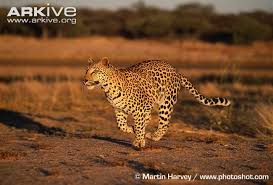Post by dinosauria101 on Feb 20, 2019 22:00:31 GMT 5
Leopard - Panthera pardus
The leopard, Panthera pardus, is a member of the Felidae family and the smallest of the four "big cats" in the genus Panthera, the other three being the tiger, lion, and jaguar. The leopard was once distributed across eastern and southern Asia and Africa, from Siberia to South Africa, but its range of distribution has decreased radically because of hunting and loss of habitat. It is now chiefly found in sub-Saharan Africa; there are also fragmented populations in Indonesia, Pakistan, India, Sri Lanka, Indochina, Malaysia, and China. Because of its declining range and population, it is listed as a "Near Threatened" species by the IUCN. Leopard are agile and stealthy predators. Although smaller than other members of the Panthera genus, they are able to take large prey due to their massive skulls that facilitate powerful jaw muscles. Head and body length is between 125 and 165 cm (49 and 65 in), and the tail reaches 60 to 110 cm (24 to 43 in). Shoulder height is 45 to 80 cm (18 to 31 in). The muscles attached to the scapula are exceptionally strong, which enhance their ability to climb trees. They show a great diversity in size. Males are about 30% larger than females, weighing 30 to 91 kg (66 to 200 lb) compared to 23 to 60 kg (51 to 130 lb) for females. Large males of up to 91 lb (200 kg) have been documented in Kruger National Park in South Africa; however, males in the South Africa's coastal mountains average 31 lb (14 kg). This wide variation in size is thought to result from the quality and availability of prey found in each habitat. Smaller sized leopards also are known in the deserts of the Middle East. Its body is comparatively long, and its legs are short.

Grey Wolf (pack of 2) - Canis lupus
The Grey Wolf (Canis lupus) is the largest wild canid, males averaging between 70 and 110 pounds depending on subspecies. The Wolf has a specialized body that has made it one of the world's most efficient hunters. Its powerful neck is a very important adaptation: it has to be strong to support the wolf's large head and is crucial for bringing down prey. The skull is 31cm (12 inches) long and is armed with an impressive array of large canines and carnassial teeth which, when coupled with huge jaw muscles that are evident from the large sagittal crest and wide zygomatic arches, give it an incredible biteforce that is strong enough to break the bones of prey and even crack the femur of moose. Wolves primarily feed on medium to large sized ungulates (up to the size of bison 10–15 times larger than themselves), though they are not fussy eaters. Medium and small sized animals that may supplement the diet of wolves include marmots, beaver, hares, badgers, foxes, weasels, ground squirrels, mice, hamsters, voles and other rodents, as well as insectivores.

Credit to Wikipedia
The leopard, Panthera pardus, is a member of the Felidae family and the smallest of the four "big cats" in the genus Panthera, the other three being the tiger, lion, and jaguar. The leopard was once distributed across eastern and southern Asia and Africa, from Siberia to South Africa, but its range of distribution has decreased radically because of hunting and loss of habitat. It is now chiefly found in sub-Saharan Africa; there are also fragmented populations in Indonesia, Pakistan, India, Sri Lanka, Indochina, Malaysia, and China. Because of its declining range and population, it is listed as a "Near Threatened" species by the IUCN. Leopard are agile and stealthy predators. Although smaller than other members of the Panthera genus, they are able to take large prey due to their massive skulls that facilitate powerful jaw muscles. Head and body length is between 125 and 165 cm (49 and 65 in), and the tail reaches 60 to 110 cm (24 to 43 in). Shoulder height is 45 to 80 cm (18 to 31 in). The muscles attached to the scapula are exceptionally strong, which enhance their ability to climb trees. They show a great diversity in size. Males are about 30% larger than females, weighing 30 to 91 kg (66 to 200 lb) compared to 23 to 60 kg (51 to 130 lb) for females. Large males of up to 91 lb (200 kg) have been documented in Kruger National Park in South Africa; however, males in the South Africa's coastal mountains average 31 lb (14 kg). This wide variation in size is thought to result from the quality and availability of prey found in each habitat. Smaller sized leopards also are known in the deserts of the Middle East. Its body is comparatively long, and its legs are short.
Grey Wolf (pack of 2) - Canis lupus
The Grey Wolf (Canis lupus) is the largest wild canid, males averaging between 70 and 110 pounds depending on subspecies. The Wolf has a specialized body that has made it one of the world's most efficient hunters. Its powerful neck is a very important adaptation: it has to be strong to support the wolf's large head and is crucial for bringing down prey. The skull is 31cm (12 inches) long and is armed with an impressive array of large canines and carnassial teeth which, when coupled with huge jaw muscles that are evident from the large sagittal crest and wide zygomatic arches, give it an incredible biteforce that is strong enough to break the bones of prey and even crack the femur of moose. Wolves primarily feed on medium to large sized ungulates (up to the size of bison 10–15 times larger than themselves), though they are not fussy eaters. Medium and small sized animals that may supplement the diet of wolves include marmots, beaver, hares, badgers, foxes, weasels, ground squirrels, mice, hamsters, voles and other rodents, as well as insectivores.

Credit to Wikipedia







